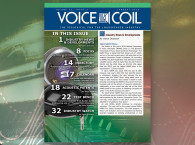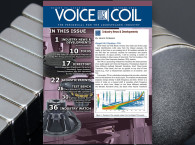 Heading for the 2020 NAMM Show in Anaheim, CA, this edition highlights all the activities that should be on the minds of every loudspeaker professional visiting the now much expanded show. The 2020 Winter NAMM Show, like the previous two shows, will benefit from the North Hall expansion of the Anaheim Convention Center, with about 200,000 ft2 of additional floor space almost all of it now devoted to professional audio exhibits. And given that reinforced perspective for the show, also the education and conference activities have increased the "pro audio" angle, with the AES@NAMM sessions representing additional value for professionals and aspiring audio professionals. In this edition, Vance Dickason highlights some of the loudspeaker-related sessions or interest. The Industry News & Developments section also discusses the Integrated Systems Europe (ISE) 2020, the next show in the loudspeaker industry calendar.
Heading for the 2020 NAMM Show in Anaheim, CA, this edition highlights all the activities that should be on the minds of every loudspeaker professional visiting the now much expanded show. The 2020 Winter NAMM Show, like the previous two shows, will benefit from the North Hall expansion of the Anaheim Convention Center, with about 200,000 ft2 of additional floor space almost all of it now devoted to professional audio exhibits. And given that reinforced perspective for the show, also the education and conference activities have increased the "pro audio" angle, with the AES@NAMM sessions representing additional value for professionals and aspiring audio professionals. In this edition, Vance Dickason highlights some of the loudspeaker-related sessions or interest. The Industry News & Developments section also discusses the Integrated Systems Europe (ISE) 2020, the next show in the loudspeaker industry calendar.
Next up, for this first edition of 2020, Nora Wong compiled three valuable informative pieces for anyone interested in headphones manufacturing. Nora Wong (Menlo Scientific, Ltd.) provided an updated list of many of the leading OEM/ODM headphone and earphone factories. This is followed by a subdirectory of headphone parts vendors, with informative commentary about each company listed. Finally, a useful schedule of headphone-centric events is also included in the Earphone and Headphone Events 2020 Calendar.
In his first Acoustic Patents article for 2020, James Croft (Croft Acoustical) reviews two different patents that were very recently awarded to Alexander B. Ralph (Winter Garden, FL) as the sole inventor and owner. The first is for a Ported Cavity Tweeter design, described as having a diaphragm frame secured to the bottom surface of the face plate, and a central aperture passing through both the face plate and the diaphragm frame. In addition, the ported cavity tweeter also includes at least one acoustic duct extending through the face plate and diaphragm frame, configured as a Helmholtz resonator to increase the output level over a range of frequencies.
The second patent is a Diaphragm Ported Tweeter, a companion design of a ring structure having an upper portion and a lower portion, and a dome-shaped diaphragm with an acoustic duct having an open first end coupled to the aperture and a second open end extending away from the aperture.
James Croft offers a look at all the related inventions and innovations that have long been associated with the ubiquitous 25 mm dome tweeter - an industry standard and the preferred high-frequency transducer. The review explains how these transducers are limited in frequency mainly due to a large signal distortion determined by the fundamental resonant frequency, and how after many attempts to remove that limitation, this invention has the potential to increase the useable low-frequency bandwidth of a tweeter, and may allow the development of new and useful driver combination formats. The second invention, basically attempts to achieve the same increase in large signal output as the Ported Cavity Tweeter by also operating as a ported, Helmholtz/bass reflex tweeter, but in this case, with the port placed in an opening in the center of the dome diaphragm.
In the first Test Bench for 2020, Vance Dickason welcomes two new companies - both well-established pro sound OEM manufacturers headquartered in Europe - that have, for the first time, submitted products for characterization.
The first product is a new 1” compression driver from LaVoce, an Italian company founded in 2008 by Elettromedia, with its R&D center located in Potenza Picena, Italy, and manufacturing based in Jiashan, China (near Shanghai), its own purpose-built ISO 9001-certified production facility. LaVoce submitted the 1” DF10.172K compression driver combined with its own HD1003 cast aluminum 90°×40° exponential horn. Designed for use with 1” throat horns, the DF10.172K has a 25.4 mm (1”) throat diameter driven by a 44.4 mm (1.75”) diameter voice coil would with edgewound copper clad aluminum wire (CCAW) on a Kapton former, driving a single-piece polyimide diaphragm and vented polyimide surround. Other features include a FEA-optimized ferrite magnet motor structure, phase plug, and diaphragm, a continuous AES-rated power handling of 60 W with (120 W program material), a 1.6 kHz recommended crossover frequency (12 dB/octave second-order high-pass), and a 2.83 V/1 m 108.5 dB sensitivity measured on the horn.
The second product, also a compression driver, comes from Oberton, a company founded in 1989 in Plovdiv, Bulgaria. Already with a respected portfolio of professional audio solutions, including high-frequency drivers and coaxial loudspeakers, for this first submission to Test Bench, Oberton sent the company’s recently released ND72CT/HB 1.4” compression driver along with the H-1464 1.4” cast aluminum 60°×40° constant directivity horn. The ND72CT version of the ND72 has a 72 mm (2.85”) diameter two-layer voice coil wound with copper-clad aluminum wire (CCAW) wound onto a Kapton former, driving a unique cotton composite diaphragm and polycotton surround - the entire assembly is field replaceable. According to Oberton, this dome has a “soft” sound and is highly recommended for use in stage floor monitors. However, the ND72 also has another alternative dome, named the Hybrid Dome, which turns the ND72CT into the ND72HB. The Hybrid Dome is a combination of carbon composite diaphragm with a center cotton composite “patch” that reduces break-up modes. The result is a dome with excellent stiffness and good internal damping and all the testing was performed mostly with this hybrid dome (ND72HB).
 Other features include a FEA-optimized neodymium ring magnet motor structure, a continuous rated power handling of 100 W with a peak power handling of 200 W, a 1 kHz recommended minimum crossover frequency (second-order high-pass filter), heatsink fins on both the front and the back of the assembly, 109 dB sensitivity, plus color-coded chrome push terminals.
Other features include a FEA-optimized neodymium ring magnet motor structure, a continuous rated power handling of 100 W with a peak power handling of 200 W, a 1 kHz recommended minimum crossover frequency (second-order high-pass filter), heatsink fins on both the front and the back of the assembly, 109 dB sensitivity, plus color-coded chrome push terminals.
The January 2020 edition of Voice Coil concludes with the traditional Industry Watch section.
Voice Coil January 2020 is available for download and already in the mail for print subscribers. Subscribers can go to - www.gotomyvcoil.com - to download this issue.
Remember, Voice Coil is available in print and download for all registered subscribers, free for industry professionals. To qualify for a free subscription to Voice Coil, or renew your subscription, go to: audioxpress.com/page/Voice-Coil-Subscriber-Services.html.

- on Magazine News
- News
The Periodical for the Loudspeaker Industry Enters 2020. Voice Coil January 2020 Now Available!
December 27 2019, 07:10
Voice Coil January 2020 is now available in print and digital. This first edition of 2020 includes two valuable directories of headphone and headphone parts vendors. In Acoustic Patents, James Croft reviews two different ported tweeter design patents awarded to the same inventor. And Vance Dickason welcomes two new companies - LaVoce from Italy and Oberton from Bulgaria - to Test Bench. LaVoce submitted the 1” DF10.172K compression driver, while Oberton sent the ND72CT/HB 1.4” Hybrid Dome compression driver.





